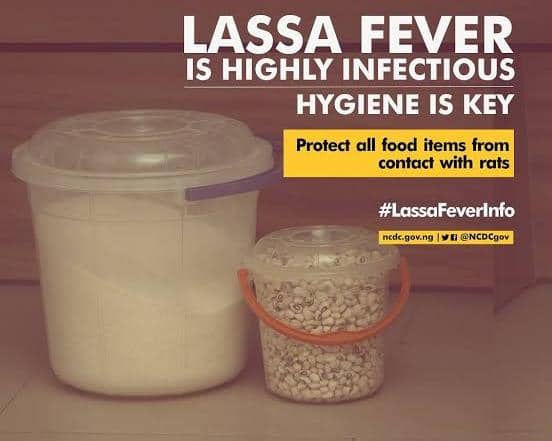Lassa Fever Alert: One Rat is Enough to Take a Life.
- Scholarstica Eguma MPH

- Oct 13
- 3 min read
Nigeria has recorded 166 deaths from Lassa fever between January 1 and September 14, 2025. The Case Fatality Rate now stands at 18.5% 2025, from 16.9% in 2024. On October 12, 2025, the Kano State Center for Disease Control issued a public health advisory regarding the onset of the Lassa fever season and the potential transmission risk across the country. Lassa fever continues to pose a serious public health challenge in West Africa, and outbreaks can impact large populations. Understanding the Symptoms, mode of transmission, and prevention can go a long way to reduce the disease burden.
What is Lassa Fever?
Lassa fever (LF) is a viral hemorrhagic illness caused by Lassa virus (LASV), an arenavirus transmitted by the rodent Mastomys natalensis. These rats live in and around most homes, contaminating uncovered food items, which serve as a medium for transmission of the disease to humans. This disease is endemic in West African countries like Nigeria, Sierra Leone, Guinea, and Liberia, and reports thousands of cases every year.

Symptoms of Lassa Fever
Lassa fever symptoms can differ greatly among individuals, ranging from mild to severe. Some patients might show no symptoms, complicating early diagnosis and timely treatment. Common signs include:
Fever: One of the first signs, fever usually appears suddenly, often exceeding 38°C (100.4°F).
Weakness: Victims often feel very tired and fatigued as the body fights the virus.
Headache: Severe headaches are frequently reported by patients.
Sore Throat: Many develop a sore throat, which may be accompanied by a persistent cough.
Gastrointestinal Issues: Symptoms like nausea, vomiting, and diarrhea can occur, with severe cases potentially leading to dehydration.
In more critical cases, Lassa fever may lead to bleeding issues, such as from the mouth, nose, or gastrointestinal tract. Shock and multi-organ failure are real threats in these situations, making early diagnosis and prompt treatment essential.

Transmission of Lassa Fever
The primary transmission route is through contact with urine, feces, or saliva from infected rodents. Here are common ways this occurs:
Direct Contact: Handling or consuming food contaminated with rodent droppings can lead to infection. For instance, research indicates that as much as 60% of households in endemic areas may have rodent contamination in food storage.
Inhalation: In places with poor ventilation, aerosolized particles from rodent waste can be inhaled, increasing the risk of infection.
Human-to-Human Transmission: This occurs primarily in hospitals if healthcare workers do not adhere to strict hygiene protocols. During the 2018 outbreak in Nigeria, healthcare settings were responsible for a significant percentage of reported infections through contact with blood or other bodily fluids from infected individuals due to inadequate protective measures.
Effective Prevention Strategies
Preventing Lassa fever requires several strategies to minimize exposure to the virus. Here are impactful measures:
Rodent Control
Control of rodent populations is crucial in endemic regions. Key actions include:
Proper Food Storage: Ensuring that food is stored in sealed, rodent-proof containers reduces contamination risks.
Sanitation: Regular cleaning of living and workspaces to eliminate potential rodent habitats is vital. In fact, improved sanitation can lead to a 75% reduction in rodent population density.
Community Awareness: Teaching communities about rodent risks and exposure reduction methods enhances overall public health efforts.

Personal Hygiene
Maintaining good personal hygiene is crucial for infection prevention. This involves:
Handwashing: Regular handwashing with soap, especially after handling food or cleaning areas where rodents may be present, significantly lowers the risk of transmission.
Use of Protective Gear: Healthcare professionals who encounter suspected cases of Lassa fever should wear gloves and masks to safeguard against exposure.

Early Detection and Treatment
Timely detection and treatment can dramatically improve survival rates in cases of Lassa fever. Effective strategies include:
Surveillance: Continuous monitoring and prompt reporting of cases to health authorities are vital for outbreak response.
Access to Healthcare: Healthcare facilities must be accessible to individuals so that they can receive timely treatment, reducing the illness’s spread.
Education: Raising awareness about the symptoms allows communities to seek medical assistance quickly. Statistics have shown that early interventions can increase survival rates by up to 90%.
Final Take Home
Recognizing the symptoms, understanding transmission routes, and implementing effective prevention strategies are fundamental to reducing this disease burden. Focusing on rodent control, promoting hygiene, and ensuring timely detection and treatment, people and communities can effectively combat Lassa fever and protect public health. We would love to hear your insights. Feel free to connect with our Infectious Disease community for valuable health tips and updates.











Comments